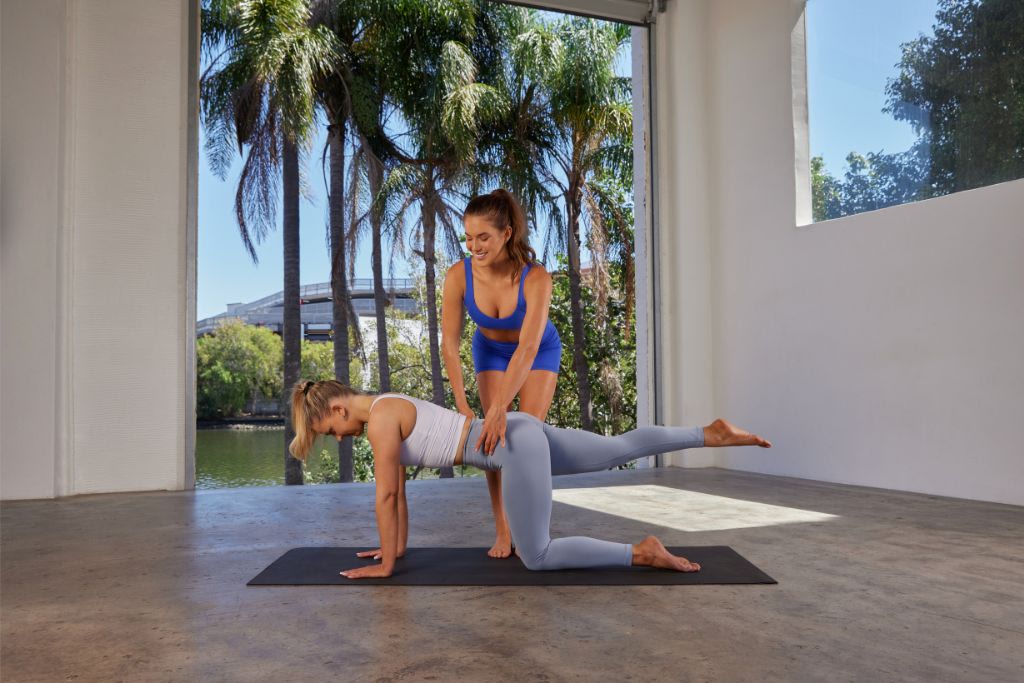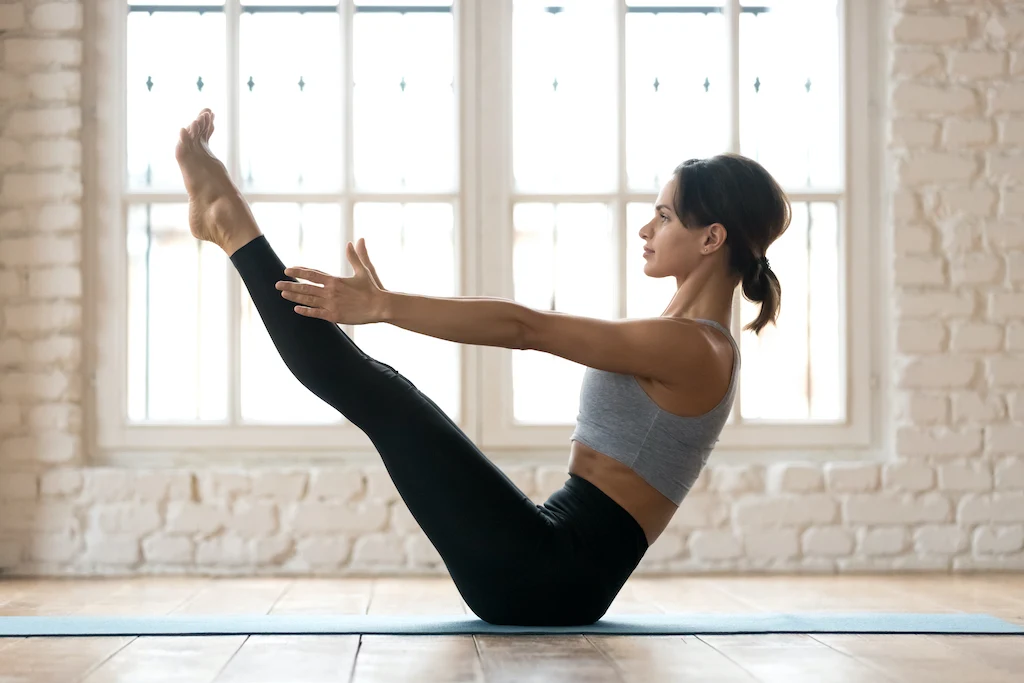Beginner’s Guide To Getting Started With Pilates

May 27, 2020

Whether you’re new to exercise or work out regularly, Pilates is a low-impact training style that can help you build strength and stability. While Pilates is definitely a disciplined practice, it’s easy to get started with Pilates at home if you’re a beginner.
You’ve probably heard of Pilates before, but sometimes there is a bit of confusion over how it differs from other styles of movement such as yoga and barre. Pilates is a training style that can be done as a full-length program, the occasional standalone session, or you can incorporate elements of Pilates within your existing routine.
Before you get started, here’s a guide to why you should do Pilates, the types of Pilates you can do, and what you need to know before your first Pilates session.
What is Pilates?
Pilates was invented by Joseph Pilates in the 1920s as a form of physical rehabilitation. It is a low-impact style of exercise that targets muscles in a precise way while increasing overall strength. According to the Pilates Foundation, Joseph Pilates based the method on the following principles: breath, concentration, centring, control, precision and flow.
There are many benefits of Pilates and it’s a style of movement that primarily builds strength in your core muscles while also improving overall flexibility and posture. During Pilates, you’ll maintain a focus on breathing techniques and precise movement. While there are different styles of Pilates such as reformer and contemporary that have been designed around pieces of equipment, Sweat’s Pilates programs and workouts can be done at home, using a mat and minimal equipment.
How to get started with Pilates
Before you start Pilates for the first time, you might want to familiarise yourself with the fundamentals of the practice. Take a look at this free, full-body Pilates workout with Sara Colquhon to to get a feel for what a Pilates workout looks like.
If you’re ready to try Pilates with Sara or On Demand Pilates with Katie Martin in the Sweat app, here are some helpful tips that will make starting your Pilates program easier.
Learn some Pilates exercises for beginners
You might find it helpful to research some basic Pilates movements before you do a class, so you're familiar with how to complete them. Try the Pilates exercises for beginners below to get started.
Set up your space
If you’re doing Pilates at home, you will need some space for your workouts. The good thing is, you don’t need a lot of room — just enough for a yoga mat on the floor. You can practice Pilates in your bedroom, living room, backyard or balcony, so long as the ground is flat and even, and you have enough space to move.
Get some equipment
Aside from an exercise mat, mat Pilates doesn't require any equipment to get started, but there are some pieces of equipment that can make movements more challenging or easier.
Some helpful and inexpensive pieces of equipment to have for your mat Pilates routine include:
Yoga mat
Dumbbells or hand weights
Resistance band
Chair
Small towel or slider
Towel
Skipping rope
Ankle weights
How are Pilates, yoga and barre different?
There is sometimes confusion as to the difference between Pilates, yoga and barre. After all, they are all low-impact disciplines and a great way to move your body at home with minimal space and equipment.
While there are many similarities between these three training styles, they each have unique qualities. Yoga can be athletic, but is usually a meditative and spiritual practice that focuses on unifying the body and mind and increasing relaxation. It also often has a greater focus on stretching and flexibility.
Pilates traditionally has a greater emphasis on rehabilitation. It can be a safer option to get started with than yoga for those who are recently injured. It also has more of a focus on building core strength and contains a series of controlled and sustained exercises that concentrate on form over reps.
The origins of barre are rooted in dance, and this style combines ballet-inspired movements with functional strength exercises. Think of this practice as a fusion of Pilates, dynamic stretching and classical ballet movements.
There are modern incarnations of Pilates, yoga and barre that are faster paced and dial up the intensity. For beginners, it’s best to start with slower, focused movements to ensure you master the fundamentals and your form as your strength and stability improves.

Pilates exercises for beginners
Before you get started with Pilates, there are some basic exercises you can learn to get a feel for the practice.
Glute bridges
This movement is a simple exercise that strengthens your glutes and hamstrings. Glute bridges can be especially helpful for those who experience back soreness or tension.
Start by lying flat on your back with your knees bent. The soles of your feet should be planted firmly on the ground about hip-width apart.
Inhale, then exhale. Press your heels into the mat, tense your glutes and lift your pelvis up off the floor until your body forms one straight line from your chin to your knees, resting on your shoulders.
Inhale and lower your pelvis to return to the mat.
Rolling like a ball
This exercise gives your entire back a good stretch by rolling out the muscles along your spine.
Start by sitting on your mat and bring your knees into your chest. Holding onto your shins, tilt your head down so you’re facing your knees. Lift your feet so they hover just above the floor.
Inhale and then exhale as you roll backwards, holding onto your shins until your shoulders touch the floor.
Then, roll back up until you’re sitting on your glutes again. Repeat for the specified number of repetitions.
Pelvic crunch
These will work your upper abdominal muscles.
Start by lying flat on your back with your knees bent. The soles of your feet should be planted firmly on the ground about hip-width apart.
Bring your hands behind your head and interlace your fingers. Keep your head and neck relaxed, and draw your shoulder blades back and down. Inhale, then exhale as you tuck your chin into your chest and bring your ribs to your hips to raise your head, shoulder blades and upper back off the floor.
Inhale as you bring your head and shoulders back down to the floor.
High plank
A Pilates plank works your shoulders and your core muscles at the same time.
Begin on all fours in the centre of the mat with your shoulders stacked over your hands and your hips stacked over your knees.
Then, step your feet to the back of the mat and lift your hips so your body forms a straight line from your head down to your heels. Ensure your core stays engaged and press firmly away from the ground to support your upper body.
Hold this position for the specified amount of time.
The hundred
This exercise is designed to improve core stability and strength.
Start by lying flat on your back, with your palms facing down on the mat beside your body. Bending your legs, raise them up above your body so they are at a 90-degree angle and your knees are stacked over your hips.
Extend your arms above your head so they are resting on the floor with your palms facing towards the ceiling. Inhale. Exhale and lift your shoulders and head off the mat. Extend your arms and legs forward in front of you.
Your legs should be straight, hovering above the ground, and your arms should be extended in front of you with your palms facing down.
Inhale. Exhale and begin to pulse your arms up and down.
Breathe in for five pulses, and out for five pulses, until you reach one hundred pulses.
Deciding which workout style is right for you
If you’re thinking about giving Pilates a go, trying out some of these beginner Pilates exercises is one of the best ways to see if this training style is right for you.

A more empowered you starts with Sweat, and our editorial team is here to bring you the latest fitness tips, trainer recommendations, wellbeing news, nutritional advice, nourishing recipes and free workouts.
* Disclaimer: This blog post is not intended to replace the advice of a medical professional. The above information should not be used to diagnose, treat, or prevent any disease or medical condition. Please consult your doctor before making any changes to your diet, sleep methods, daily activity, or fitness routine. Sweat assumes no responsibility for any personal injury or damage sustained by any recommendations, opinions, or advice given in this article.
Fitness